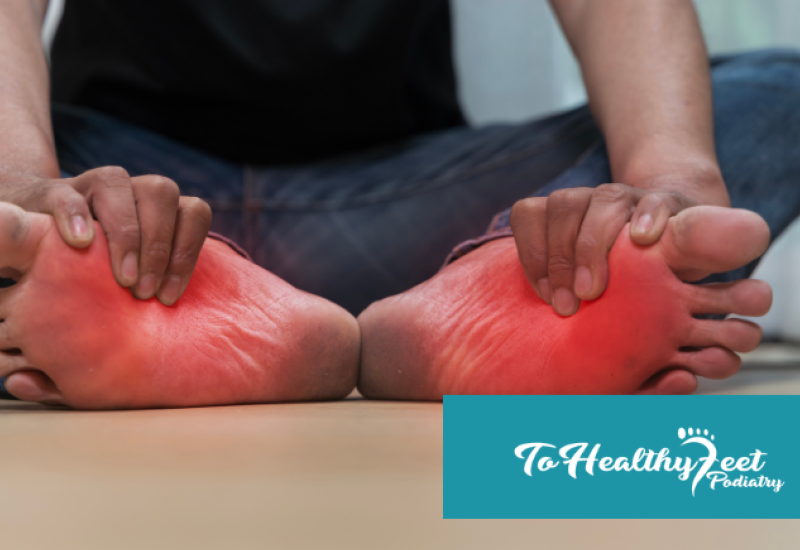What Causes Plantar Fasciitis?
It is not clearly understood exactly what causes plantar fasciitis, but there is a connection between repetitive motion and activities that put significant pressure on the bottom of your foot. You are at increased risk of developing plantar fasciitis if you:
- Run or exercise frequently
- Are overweight
- Work at a job that requires long periods of standing
- Have structural impairments like flat feet or high arches
- Wear unsupportive shoes
Stretches To Relieve Plantar Fasciitis Pain
Tight muscles in your feet and calves can make your plantar fasciitis pain worse. These simple stretches will loosen muscles in your feet and calves and relieve your plantar fasciitis pain.
Stretch #1
Keep your injured foot flat against the floor and keep your knee straight. Extend your other foot and lean forward while maintaining your weight on your back foot. Hold this position for 15-30 seconds. You should feel this stretch in your heel and calves.
Stretch #2
Sit comfortably on a chair or the floor. Flex your foot up and back. Grasp the toes of your injured foot and gently pull them toward you until you feel a stretch in the arch of your foot. Hold this for 15- 30 seconds. You can also use a towel or exercise band across the toes of your foot to pull gently back.
Stretch #3
This stretch requires a staircase. Stand on a step with the balls of your feet and use the staircase banister for support. Slowly drop your heels while relaxing your calf muscles. Your heels should be lower than the step. Hold this stretch for 15-30 seconds then lift your heels back to level with the rest of your foot. Repeat the drop for a deeper stretch across the bottom of your foot.
Stretch #4
Use a staircase for this stretch too. Standing on the ground, place your toes against the bottom stair riser while keeping your heel on the floor. Bend your knee slightly and push your toes against the riser until you feel a stretch across the bottom of your foot.
Stretch #5
While sitting on a chair, roll your foot back and forth across a solid cylinder for one minute. You can use a frozen water bottle, a chilled can, or a foam exercise roller.
Bonus Strengthening Exercises
Strengthening the arches in your feet can help reduce pain and prevent further injury to your plantar fascia. Try these 2 bonus exercises to increase your arch strength.
#1: Place a light towel on the floor and with your bare foot, use your toes to gather the towel and pull it towards you.
#2: Scatter marbles on the floor and place a cup or dish next to them. Use your toes to pick the marbles up and release them into the container.
Diagnose And Treat Your Plantar Fasciitis With Manhattan’s Top NYC Podiatrists
If you are experiencing stiffness and pain across the bottom of your foot or in your heel you may have plantar fasciitis. If conservative forms of treatment like over-the-counter medications and stretching exercises are no longer relieving your plantar fasciitis pain, there are other treatment options available. After diagnosis, your podiatrist may recommend physical therapy, custom orthotics, splinting, platelet-rich plasma injections, or minimally invasive surgery. The team of expert NYC podiatrists at To Healthy Feet in Manhattan can diagnose your plantar fasciitis and customize a treatment plan to get you back on your feet.
If you are experiencing pain due to plantar fasciitis or any other foot or ankle condition pain, call To Healthy Feet Podiatry at 1-917-398-3668 or fill out the contact form to book your appointment at our Upper East Side, Times Square, Midtown Grand Central, or Downtown Wall Street locations today.
FAQ
Q: If the bottom of my foot hurts, why do I need to stretch my calf?
A: There is a piece of tissue that covers the calf muscles and it extends down into the bottom of your foot. When one end of the tissue is too tight it causes pain at the other end. If you loosen the tissue in your calf by stretching it, it will stop the pulling on the bottom of your foot and relieve the pain.
Q: Why does my plantar fasciitis seem to flare up in the morning?
A: When your foot is in a relaxed position while you sleep, it causes the tissues of the plantar fascia to contract and when you wake up and take those first steps the tissue stretches and this causes the pain you feel.
Q: Can injections help relieve my plantar fasciitis pain?
A: Your podiatrist may recommend injection therapy to treat your plantar fasciitis pain. This may include cortisone, needle tenotomy, or PRP (platelet-rich plasma) injections. To learn more about this option read How A Podiatrist Can Treat Plantar Fasciitis With Injections.




